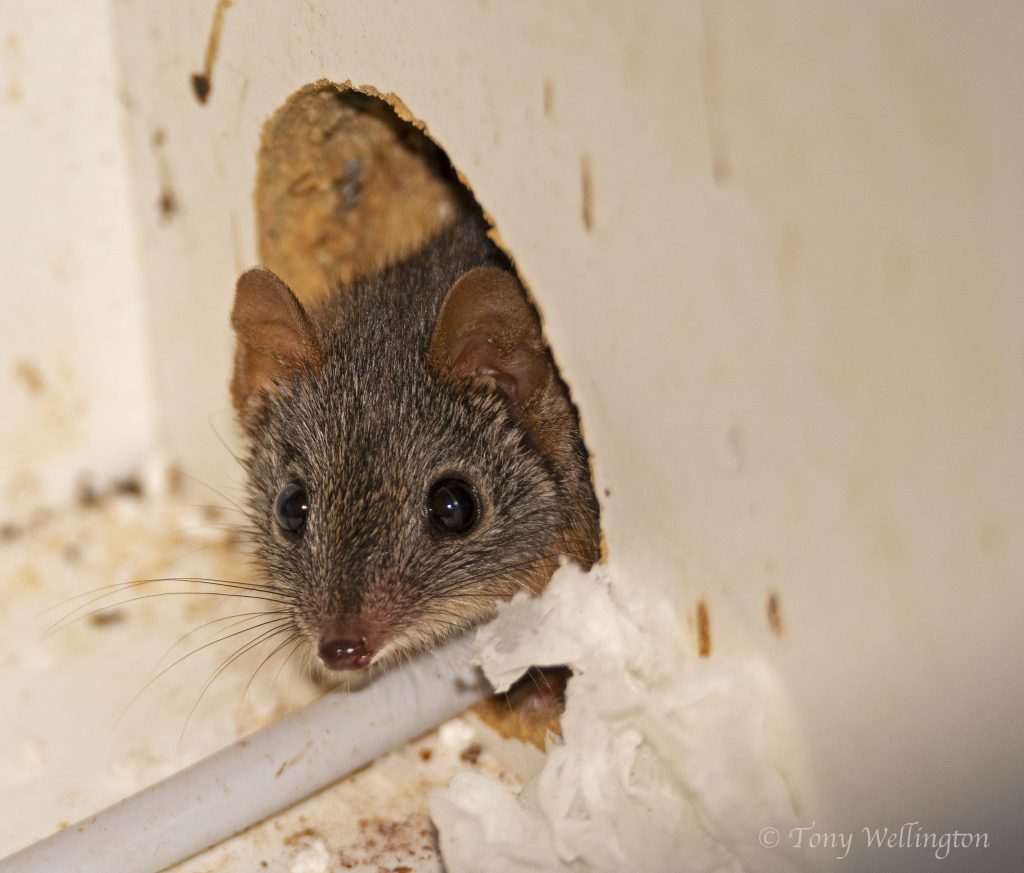If you’re a believer in reincarnation, try not to come back as an Antechinus. Sure, they may look cute, but the males only live for one year and the females are lucky if they survive two years.
The most common Antechinus in our area is the Yellow-footed Antechinus – also known as the Mardo. It’s a small, mouse-sized marsupial, not a rodent. Antechinus can be distinguished from ordinary house mice by their slightly longer, pointier nose, and a touch of rufous colour on sides and legs. They also have a fold in their ears – a sort of double lobed outer ear which is not present on rodents. What’s more, they don’t have the characteristic musk smell of rodents.
Antechinus mainly hunt at night and spend their days in communal nests. These can be in tree crevices and logs or else in wall cavities, behind cupboards and even inside sofas. In the days before flat screen TVs, the old TV cabinet was a popular option. Compared with their other Antechinus cousins, the Yellow-footed variety are more inclined to be out and about during the day.
The Antechinus diet consists mainly of insects including cockroaches, spiders and centipedes. But they’re not fussy eaters and will also consume flowers, nectar, small birds and house mice. If you discover a mouse skin turned inside out, then you’ve found the leftovers from an Antechinus feast.
These animals dart about fearlessly. They’re either stationary or else running at full pelt. There’s no in-between. They can also jump surprisingly high, and even run along branches while upside down. Plainly they lead a hectic lifestyle and so are best known for how they die rather than how they live.

During the breeding cycle, the males rush about fighting and mating, which eventually causes them to drop dead from stress and exhaustion. It seems that all that expended energy results in a compromised immune system. There are accounts of males at the end of a three-week mating period covered in sores and with their hair falling out.
Some females of the Yellow-footed Antechinus also die after weaning their first offspring, but others survive to breed for a second season.
The pouch is an open slit on the belly. Females give birth to undeveloped naked young that latch onto teats in the pouch where they remain for around 50 days. After leaving the pouch, they cling to their mother’s back as she scampers about.
Here’s another reason why you may not want to be reincarnated as an Antechinus: a single copulation can last up to 12 hours. Phew!


This Post Has One Comment
Nice story Tony. I think I have a resident antechinus at the moment – have certainly had them in the past.
Here is my ode to them:
My Little Antechinus
There’s an Antechinus in my house
He’s smaller than a rat
but he’s larger than a mouse
He is a native Dasyure –
a carnivorous marsupial
He’s cute and quick
and likes to run up and down the walls.
He’ll sit atop the picture frames and twitch his whiskers at us
He likes to eat the moths and flies
and particularly the spiders!
He steals my kitchen paper
to make himself a bed
We’ve suggested that he live outside –
but he prefers inside instead
His big dark eyes and soft grey fur
make him so endearing
His anti-gravity antics are
really quite appealing!
A prehensile tail and little hands
to grasp and climb and leap with,
but my little antechinus must
beware the girl he sleeps with!
for when my antechinus takes himself a wife,
the price he pays is very high,
for he pays with his life.
by Jane Powell 2012